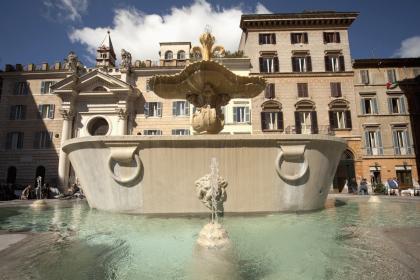
The church in a small square of the Rione Regola, a short distance from the churches of San Paolo alla Regola and Santa Maria in Monticelli, has retained the title of an older religious building. The latter is attested as early as the first half of the 10th century as “Sancti Salvatoris de Domno Campo” and later as “San Salvatore in Campo” in a bull of Pope Urban III dated 1186. The etymology of the term “Campo” is uncertain. Some trace it back to the square in which it stood (in the Middle Ages, large squares were called “campi”, i.e. fields because they lacked a pavement and were often overgrown by vegetation) and some link it to a certain dominus Campo, abbot of the great Benedictine abbey of Farfa, who is said to have erected or restored the church.
The old church, which in 1551 had been the first seat of the confraternity of the Trinità dei Pellegrini founded by Filippo Neri, was demolished in 1638 during the extension works of the Palazzo del Monte di Pietà. The following year, however, Pope Urban VIII entrusted Francesco Peparelli, one of the architects active in the renovation of the palace together with Carlo Maderno and Francesco Borromini, with the task of rebuilding the church in its present location. The architect designed a simple, linear façade for the new building, divided into three sections by plain pilasters. The crowning pediment of the façade encompasses a fresco depicting the Saviour (it. Salvatore). The church is today the seat of the Eritrean Coptic Orthodox community.
A curiosity: in 1622, near the ancient church of San Salvatore, a magnificent Roman sculpture from the 2nd century AD (a copy of an older Greek sculpture) was found while excavating a drain. It is the so-called Ares Ludovisi, “the most beautiful Mars of antiquity” according to the famous German archaeologist Winckelmann. The statue owes part of its fame to the restoration by Gian Lorenzo Bernini (who added a small cupid, among other things) and is today preserved in Palazzo Altemps.
Piazza Farnese

 Condividi
Condividi
Church of the Santissima Trinità dei Pellegrini

 Condividi
Condividi
Galleria Spada

 Condividi
Condividi
Church of Santa Maria in Monticelli

 Condividi
Condividi
Information
For the timetable of the masses and visiting conditions, please consult the contacts.
 Condividi
Condividi
Location
To find out about all accessibility services, visit the Rome accessible section.











































